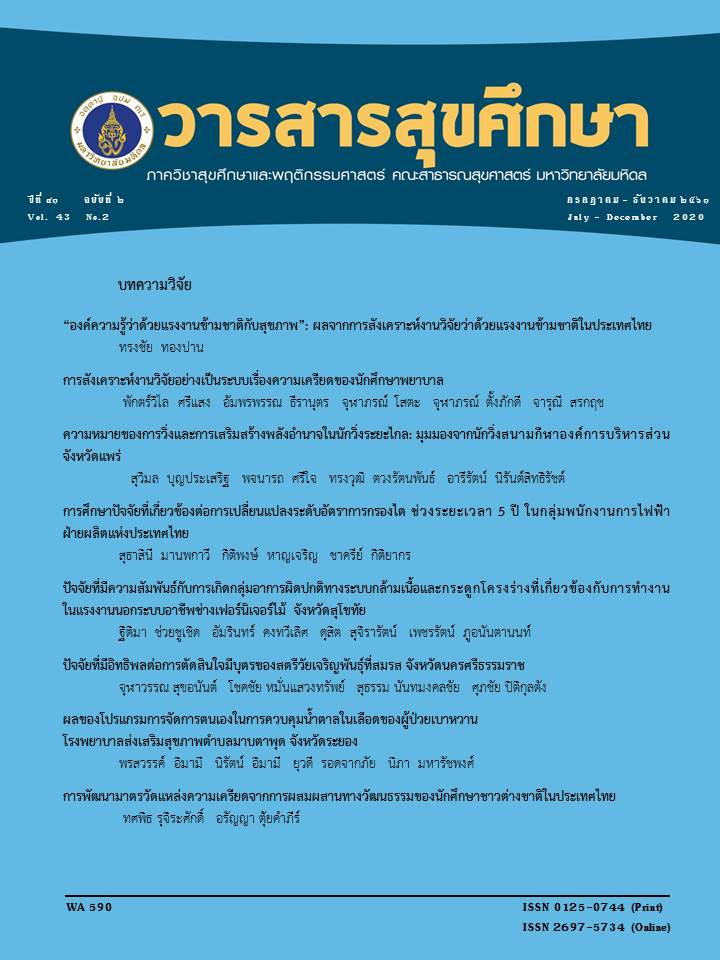Community Context Management of Ban Huai Fai, Pa Sang District, Lamphun Province That is Supplemented by Ghost Pit Charcoal Kiln to Reduce Smoke Pollution that Affects the Quality of Life
Main Article Content
Abstract
The objective of this article is to study the guidelines for managing the context of Ban Huai Fai community, Pa Sang District, Lamphun Province, to be a guideline for the management of pollution from smoke from charcoal burning using ghost pit burners that affect the quality of life of villagers in the community. Found that in the community, mainly engaged in agriculture, gardening in the Longan, and supplementing the occupation by burning charcoal from longan wood chips obtained from pruning in the longan plantations in the community where wood chips are used as renewable energy such as used as firewood for sale in the longan plant use as firewood in the household. There is still a large amount of wood chips remaining. From the original method of charcoal burning or a ghost pit furnace in that community. From the above combustion, smoke pollution causes daily problems and causes respiratory diseases. The community is aware of the problem and creates an appropriate burning method and reaches the community by burning charcoal in a 200 liter tanks and developing an efficient and hygienic charcoal burning profession as part of managing the community context. Can help alleviate smoke pollution that affects the quality of life in the community and is a guideline for other communities.
Article Details
References
2. มูลนิธิพลังงานเพื่อสิ่งแวดล้อม. บทสรุปผู้บริหารโครงการศึกษาและวิเคราะห์ข้อมูลการใช้พลังงานทดแทน ในกลุ่มวิสาหกิจชุมชน และอุตสาหกรรมขนาดเล็กของประเทศไทย. กรุงเทพมหานคร: มูลนิธิพลังงานเพื่อสิ่งแวดล้อม; 2559.
3. The Forescope. หลักการออกแบบของศตวรรษที่ 21 [อินเทอร์เน็ต]. 2562 [เข้าถึงเมื่อ14 มกราคม 2563]; เข้าถึงได้จาก: www.facebook.com /The Forescope.
4. Jeffrey M. Hiatt แต่ง จันทร์วิภา พิพัฒนกุล. (พิมพ์ครั้งที่ 8). ADKAR สุดยอดโมเดลเพื่อการเปลี่ยนแปลง. กรุงเพพมหานคร: ซีเอ็ดยูเคชั่น; 2561.
5. ยุทธนา เขาสุเมรุและคณะ. คู่มือการจัดการสวนลำไย. เชียงใหม่ : สถาบันถ่ายทอดเทคโนโลยีสู่ชุมชน มหาวิทยาลัยเทคโนโลยีราชมงคลล้านนา; 2559.
6. สำนักอนามัยสิ่งแวดล้อม. คู่มือวิชาการ แนวทางการประกอบกิจการที่เป็นอันตรายต่อสุขภาพประเภท การเผาถ่านหรือสะสมถ่าน. กรุงเทพมหานคร: สำนักงานกิจการโรงพิมพ์องค์การสงเคราะห์ทหารผ่านศึก; 2555.
7. กองประเมินผลกระทบต่อสุขภาพ กรมอนามัย กระทรวงสาธารณสุข. แนวทางการเฝ้าระวังพื้นที่เสี่ยงจากมลพิษทางอากาศ กรณีหมอกควัน [อินเทอร์เน็ต]. 2558 [เข้าถึงเมื่อ 9 มิถุนายน 2563]. เข้าถึงได้จาก: http://hia.anamai.moph.go.th/download/hia/manual/book/book43.pdf. page13.
8. สำนักส่งเสริมการมีส่วนร่วมของประชาชน. 2561. พลังงานชีวมวลแก้ปัญหาหมอกควัน. [อินเทอร์เน็ต] 2561 [เข้าถึงเมื่อ 18 มีนาคม 2562]. เข้าถึงได้จาก:www.ppp.energy.go.th/.
9. กรมส่งเสริมคุณภาพสิ่งแวดล้อม. การถ่ายทอดเทคโนโลยีพลังงานทดแทนและอนุรักษ์พลังงาน. กรุงเทพมหานคร: สถาบันพัฒนาและถ่ายทอดเทคโนโลยีสิ่งแวดล้อม; 2557.
10. คณะวิทยาการจัดการ. การถ่ายทอดภูมิปัญญาท้องถิ่น [อินเทอร์เน็ต]. 2560 [เข้าถึงเมื่อ 20 มีนาคม 2562]. เข้าถึงได้จาก:www.bc.lpru.ac.th/culture/?p=327.


